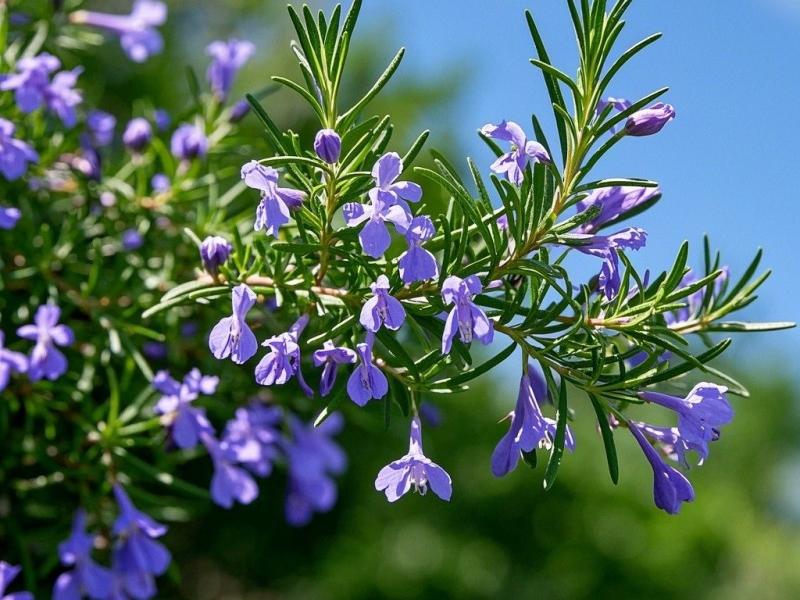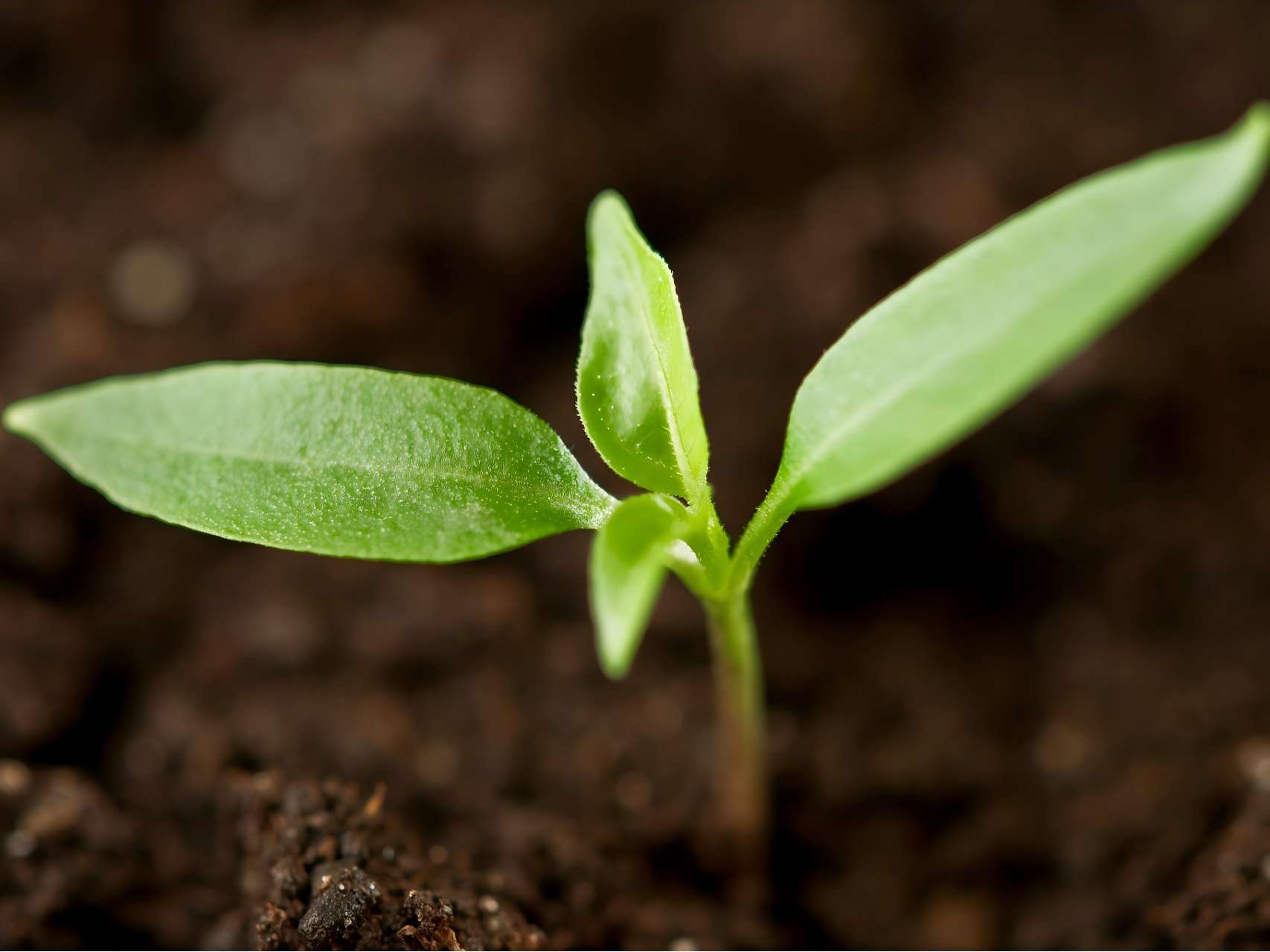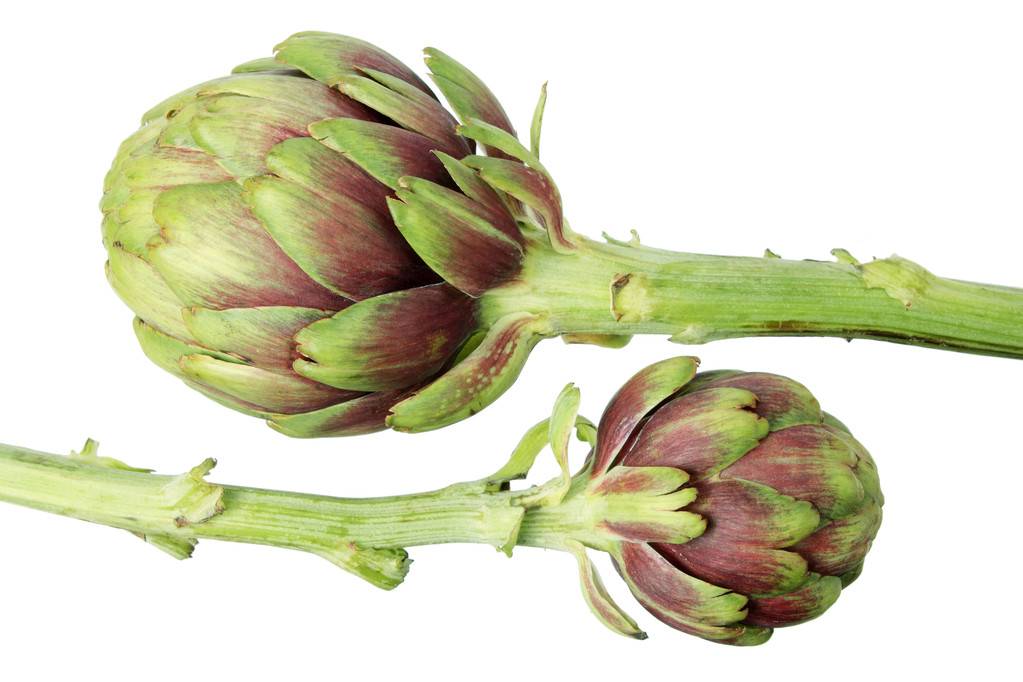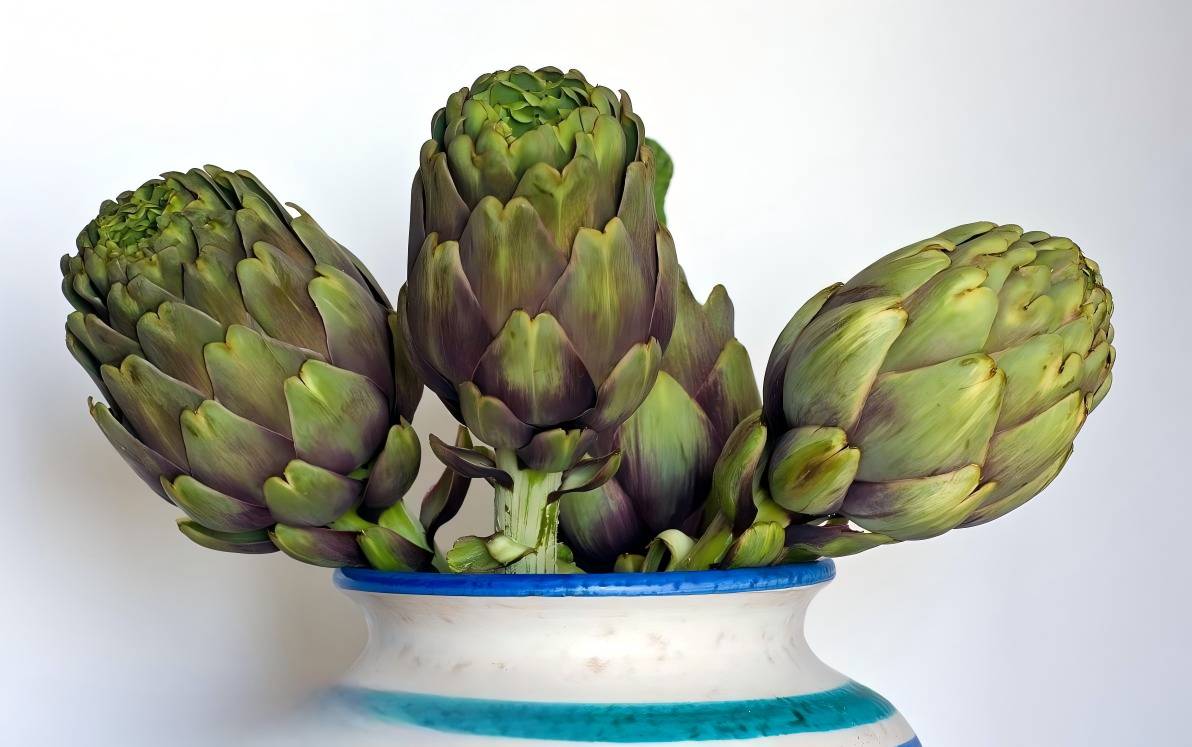Study on the Active Ingredients in Artichoke Extract Powder
Artichoke (Cynara scolymus L.), also known as chrysanthemum thistle, globe thistle, and vegetable thistle, is a perennial thistle plant in the Asteraceae family. Artichokes are native to the Mediterranean coast and are currently cultivated most in France, followed by Italy and Spain. They are also cultivated in China, including Shanghai, Zhejiang, and Yunnan. In addition to being eaten fresh, artichokes are also salted, frozen and processed into canned products, and can also be made into health tea[1], aperitifs, oral capsules, cosmetics and other products. In order to promote the comprehensive development and utilization of plants in this genus in China, this paper reviews their chemical composition and pharmacological activity, and looks at the prospects for their development.
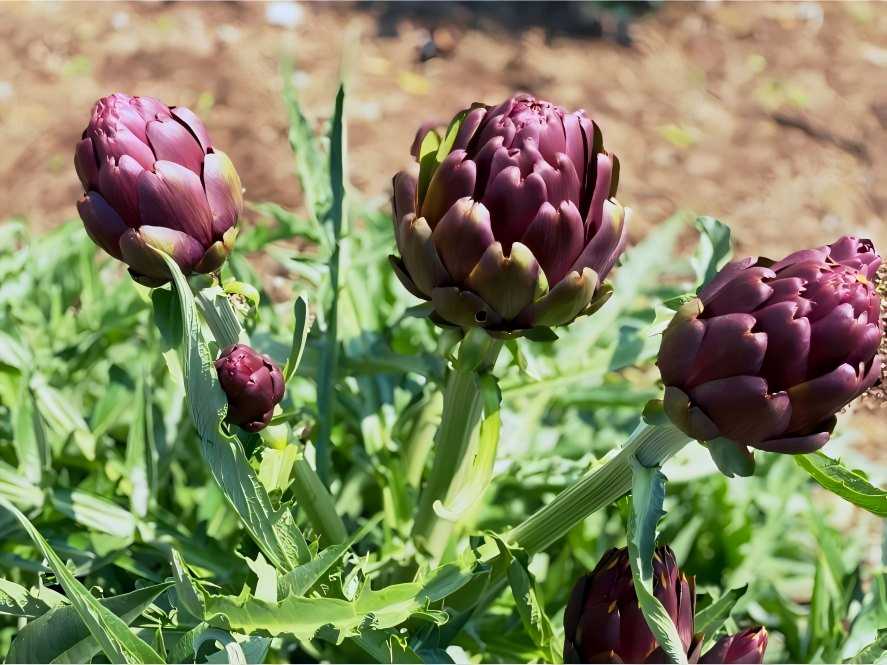
1 Active ingredients in artichoke extract
Artichoke extract powder contains major functional compounds such as phenols, flavonoids (mainly found in the leaves), and terpenes, as well as relatively high levels of vitamins and minerals [2, 3]. It is a health-promoting vegetable with high nutritional value and is known as the “king of vegetables”.
1.1 Phenolic compounds
Katrin S., Mulinacci N. [4, 5] and others used an HPLC-MS chromatograph to conduct qualitative and quantitative research on the chemical composition of artichokes, identifying a total of 22 compounds, including 11 caffeoylquinic acid compounds, namely cynarin, caffeic acid, chlorogenic acid, 1-O-caffeoylquinic acid, 3-O-caffeoylquinic acid, 4-O-caffeoylquinic acid, 5-O-caffeoylquinic acid, 1,3-di-O-caffeoylquinic acid, and 1,3,4-tri-O-caffeoylquinic acid. quinic acid (5-O-caf-feoylquinic acid), 1,3-dioxo-caffeoylquinic acid (1,3-di-O-caffeoylquinic acid), 3,4-dioxo-caffeoylquinic acid (3,4-di-O-caffeoylquinic acid), 3,5-dioxo-caffeoylquinic acid (3,5-di-O-caffeoylquinic acid), 1,5-dioxo-caffeoylquinic acid (1,5-di-O-caffeoylquinic acid), 4,5-dioxo-caffeoylquinic acid ffeoylquinic acid ), 1,5-dioxo-caffeoylquinic acid (1,5-di-O-caffeoylquinic acid), 4,5-dioxo-caffeoylquinic acid (4,5-di-O-caffeoylquinic acid). Among them, the content of artichoke acid is the highest.
In addition, Xianfeng Zhu [6] and others isolated the above two polyphenols: 3,5-dioxo-caffeoylquinic acid and 4,5-dioxo-caffeoylquinic acid from the n-butanol extract of artichoke leaves. Liu Rong [7] and others isolated two phenolic glycoside compounds from artichoke leaves, one of which is a new compound. The structure was identified by spectroscopic methods as 2-methoxy-4-(2,3-dihydroxy-propionyl) -phenyl-1-O- (6'-O-galloyl) -β-D-glucopyranoside.
1.2 Flavonoids
Mingfu Wang [8], et al. conducted a chemical composition study on artichoke buds and leaves, and obtained six flavonoids, namely naringenin rutinoside, naringenin glucoside, apigenin-7-O-rutinoside, apigenin-7-O-glucoside, luteolin-7-O-rutinoside, and luteolin-7-O-glucoside.
Katrin S., Markus P., Reinhold C. [9], et al. used an HPLC-MS chromatograph to analyze the chemical composition of artichoke. The results showed that the flower heads of artichokes contain anthocyanins, including: 3,5-dioxo-glucopyranoside, 3-O-glucopyranoside, and 3,5-malonyl glucopyranoside.
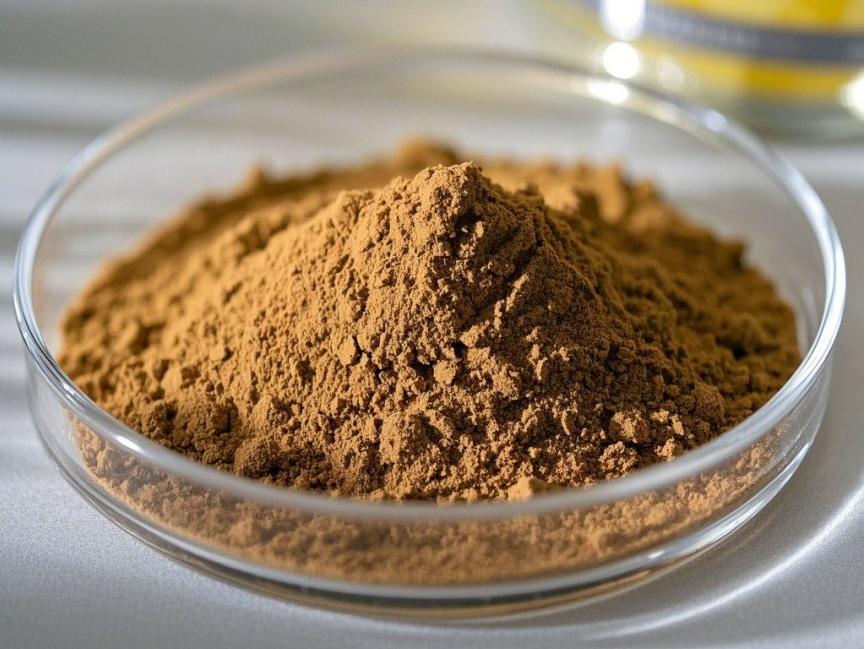
1.3 Terpenoids
Hiroshi S. [10] and others isolated six terpene compounds from an ethyl acetate extract of artichoke leaves: cynaropicrin, agerin B, grosheimin and cynaracoside A-C. Liu Rong [11] and others isolated two sesquiterpene lactones from artichoke leaves, one of which is a new compound. Its structure was determined by spectroscopic methods to be 3β, 8α, 11α, 13-terahydroxy-10 (14) -guain-1α, 4β, 5α, 6βH-6α-12-olide. Li XL [12] and others isolated cynarinin A, cynarinin B, dehydro- cynaropicrin, agerin A, cynarascoloside C, and cynartriol.
Feranda E. [13] and others established a HPLC analytical methodology for the terpenoids in artichoke.
1.4 Other
In addition to the above three main functional compounds, Liu Huiwen [14] used a cation exchange column for separation, a fluorescence detector for detection, pH gradient elution, and o-phthalaldehyde-2-mercaptoethanol post-column derivatization to successfully isolate and detect artichoke, which is also rich in medicinal ingredients such as asparagine that are beneficial to the human body. In addition, Katrin S., Erna[15] and others have shown that the flower heads, roots and leaves of artichokes also contain inulin, phytosterols and essential oils.
Mingfu Wang [8] and others have analysed the nutrients in artichoke leaves and found that they also contain a large amount of VC, minerals, amino acids and other nutrients, as well as crude fibre, crude fat, β-carotene and soluble sugars.
2 Pharmacological activity
Artichoke extract has physiological activities such as antioxidant, liver protection, cholesterol reduction, gastrointestinal function improvement, liver detoxification enhancement, digestion promotion, blood circulation improvement, arteriosclerosis prevention, cardiovascular protection, and amino acid metabolism promotion. In addition, artichoke contains cynarin (cynarinic acid), which has pharmacological activity for the treatment of chronic hepatitis [16-19].
2.1 Antioxidant effect
Artichoke extract is an important antioxidant. Wang et al. [20, 21] studied the scavenging effect of the polyphenols isolated from artichoke on DPPH free radicals, Antoni, Jimenez-Escrig [22, 23] and others determined the ability of artichoke extract to scavenge DPPH, reduce ferric iron ions (FRAP), and inhibit the oxidation of human low-density lipoprotein (LDL) catalyzed by Cu in vitro.
Gebhardt [19] conducted an in vitro antioxidant test on rat liver cells, and the results showed that an aqueous extract of 0.001 mg/ml could reduce the content of malondialdehyde (MDA), while not affecting the level of glutathione (GSH) in liver cells. On the contrary, it reduced the loss of (GSH) and the loss of glutathione disulfide (GSSG). The above experimental results all indicate that artichoke extract (polyphenols, concentrated in the leaves) has antioxidant activity. Gebhardt's experiments also concluded that the antioxidant effect of artichoke extract is the main reason for its hepatoprotective and liver regeneration effects.
Perez-Garcia [24] et al. used the fluorescent probe dichlorofluorescein diacetate and flow cytometry to study the effect of artichoke extract on the antioxidant activation of human white blood cells. The results showed that artichoke glycosides, caffeic acid, chlorogenic acid and 3, 4, 5, 7-tetrahydroxyflavone can inhibit oxygen stress response in a concentration-dependent manner and exerting antioxidant activity.
Zapolska-Downar et al. studied the effects of water and ethanol extracts of artichoke leaves on the protective effects of oxidative stress on endothelial cells and monocytes. They found that both extracts inhibited the production of reactive oxygen species in endothelial cells and monocytes under basal and stressed conditions in a dose-dependent manner, demonstrating that artichoke extracts have a significant protective effect against oxidative stress in endothelial cells and monocytes caused by inflammatory mediators and ox-LDL.
2.2 Cholesterol-lowering effect
Artichoke extract inhibits cholesterol biosynthesis and LDL oxidation. Artichoke extract indirectly inhibits liver cholesterol biosynthesis, thereby reducing lipids in human serum (hypolipidemic influence). Experiments have shown that the flavonoids in artichoke, such as 3,4,5,7-tetrahydroxyflavone, have a cholesterol-lowering effect [25].
Gebhardt [26] incubated artichoke extract with β-glucosidase to enhance its effect of inhibiting cholesterol synthesis. The results confirmed that artichoke glycosides act on β-glucosidase to hydrolyze and release 3,4,5,7-tetrahydroxyflavone, thereby inhibiting cholesterol synthesis.
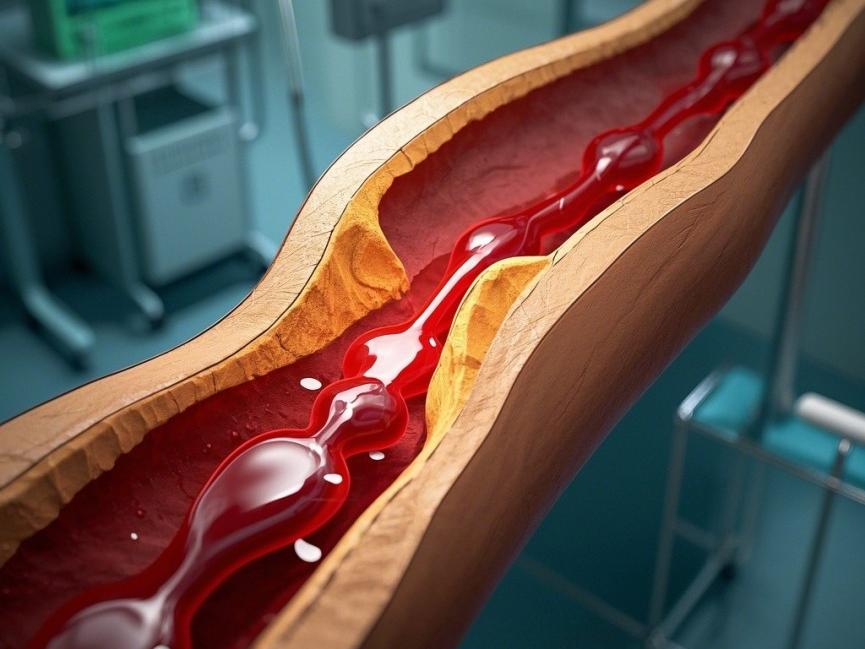
In English [27], a randomized controlled trial compared the use of artichoke extract alone to treat hypercholesterolemia with patients given a placebo or a reference drug. He also used CY450 coated tablets (trade name Valverde Artischocke bei Verdauungsbeschwerden, containing 450 mg artichoke extract) to treat hyperlipidemia and observe the therapeutic effect and tolerability. The results clearly showed that artichoke extract can be used to treat hyperlipidemia and prevent atherosclerosis and coronary heart disease.
2.3 Antimicrobial effect
Experimental studies by Xianfeng Zhu [6] and others have demonstrated that the n-butanol extract of artichoke has antimicrobial activity. The extract has the strongest antibacterial activity against seven species of rod bacteria and four species of yeast and four species of mold. Among them, luteolin-7-O-rutinoside and artichoke glycoside have relatively high antimicrobial activity, and antifungal activity is stronger than antibacterial activity. In addition, it is reported in the literature that the flavonoids in artichoke have a regulatory effect on endothelial cell function [28].
Artichoke's cholesterol-lowering and antibacterial effects make it useful in the treatment of hyperlipidemia, coronary heart disease, atherosclerosis and other diseases. It also has medicinal and health-care functions such as anti-ulcer, anti-allergic, antibacterial, anti-inflammatory, anti-oxidant, anti-aging, and treatment of cardiovascular and cerebrovascular diseases [28, 29]. Artichoke extract has the pharmacological activity of lowering blood lipids and anti-atherosclerosis, which is mainly through the influence of cholesterol and lipids in the liver synthesis decomposition pathway to regulate lipid levels [30-32].
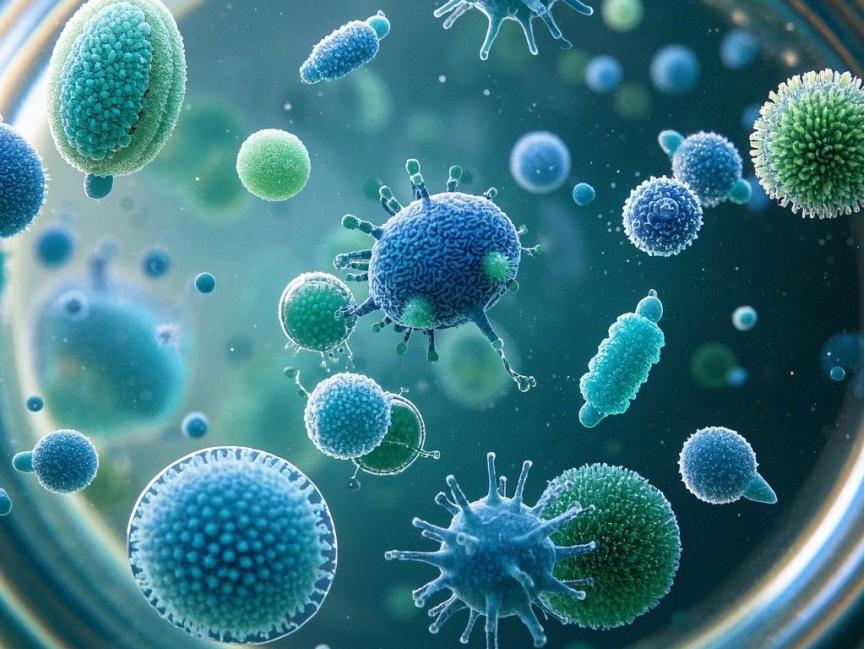
2.4 Effect on the digestive system
2.4.1 Treating indigestion
In Europe, artichoke has long been used to treat indigestion. A Kraft [25] trial showed that artichoke extract is effective in treating symptoms such as bloating and nausea. Modern medical research has pointed out that the mechanism by which artichoke extract treats indigestion is to promote bile secretion. In a clinical trial, 20 male patients with acute and chronic metabolic disorders were randomly divided into 2 groups, one group was given artichoke extract and the other was the control group. The results showed that after 30 minutes, the bile secretion in the artichoke extract group increased by 127.3%, and after 60 minutes, it increased by 151.5%, which was a significant difference compared to the control group. This indicates that artichoke extract can be used to treat digestive disorders and fat malabsorption caused by insufficient bile secretion. No side effects of artichoke extract were observed in the study.
In a double-blind, placebo-controlled, randomized clinical trial, Holtmann [33] et al. randomly administered artichoke extract tablets or placebo to 247 patients with functional dyspepsia (FD). The total score was used as the primary evaluation index, based on the number of dyspepsia attacks per week. The results showed that artichoke extract was significantly more effective than placebo in relieving the symptoms of functional dyspepsia and improving the patients' quality of life.
2.4.2 Treating irritable bowel syndrome
Bundy [34] and others treated 208 adult patients with irritable bowel syndrome (IBS) with artichoke extract for 2 months. The incidence of IBS decreased by 26.4%, and symptoms of constipation or diarrhea improved significantly. After treatment, the total symptom score of the Nepean Dyspepsia Index (NDI) decreased significantly by 41%. Similarly, the NDI quality of life (QOL) score improved significantly by 20% in both groups after treatment, demonstrating that artichoke extract has a significant effect on relieving IBS symptoms and improving IBS quality of life.
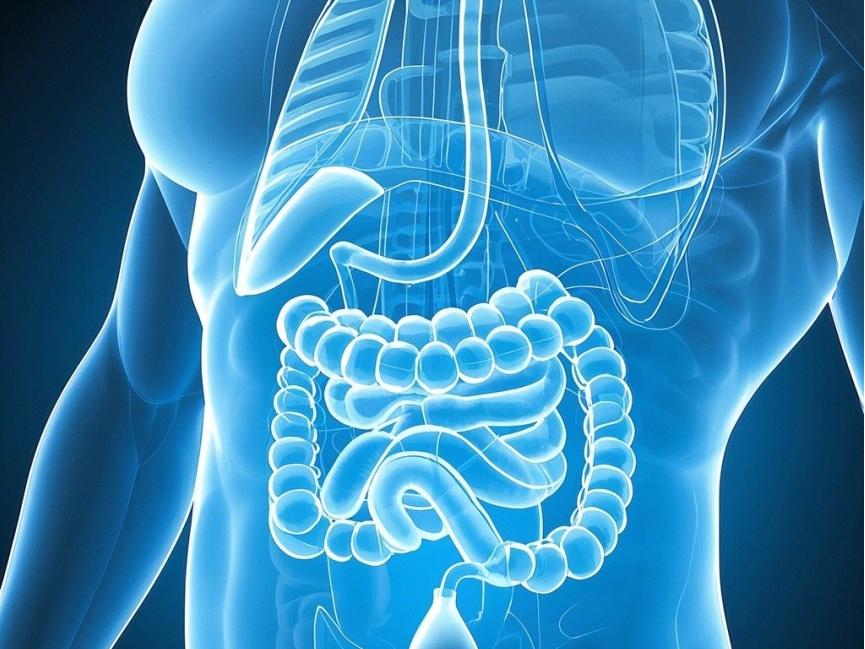
2.4.3 Choleretic effect
Gebhardt [35] studied the choleretic effect of artichoke extract using primary rat hepatocytes and bile-producing fluorescent compounds in vitro and found that artichoke extract can stimulate bile secretion. Rodriguez [36] and others gave Wistar rats artichoke extract and fed it for 7 consecutive days. After anaesthesia, the effect of artichoke extract on bile flow and bile composition in rats was studied. It was found that artichoke extract could significantly increase bile flow, similar to the control dehydrocholic acid (DHCA), and artichoke extract significantly increased the concentration of total bile acids, and its effect was more pronounced than DHCA.
Gebhard et al. [37] studied the stimulating effect of artichoke extract on bile secretion. They added taurine to the culture medium of primary rat hepatocytes to inhibit bile secretion, and added artichoke extract at different concentrations to observe its effect on bile secretion and its preventive effect on bile duct deformation. The results showed that when added together with bile acid, prevented the abnormal deformation of the bile duct membrane caused by taurine bile acid in a dose-dependent manner. Pretreatment of hepatocytes with artichoke extract had a similar effect, confirming that artichoke extract has a strong anticholinergic effect on cholestasis caused by taurine bile acid and has a protective effect on the liver. This may be related to the flavonoids and metabolites it contains.
2.5 Regulation of endothelial cell function
Endothelial dysfunction is an early stage of atherosclerosis, which is often determined by ultrasonic measurement of flow-mediated vasodilation (FMV), vascular cell adhesion molecule-1 (VCAM-1), intercellular adhesion molecule-1 (ICAM-1) and E-selectin and other body fluid markers. Foreign researchers [36] observed the effect of artichoke juice food additives on arm FMV in hyperlipidemic patients, measured the baseline levels of soluble VCAM-1, ICAM-1, and E-selectin in the serum, and arm FMV. They found that after taking artichoke, the patients' triglyceride levels increased, and total cholesterol and LDL cholesterol decreased; The control group's total cholesterol and LDL cholesterol decreased significantly, and the treatment group's VCAM-1, ICAM-1 and arm FMV all decreased compared to before treatment. There was no change in the control group before and after treatment. It can be seen that artichoke food additives can indeed regulate endothelial function in patients with hypercholesterolemia.
In the vascular system, nitric oxide produced by endothelial nitric oxide synthase (eNOS) has an anti-thrombotic and anti-atherosclerotic effect. Therefore, increasing eNOS expression can protect the cardiovascular system. ALE can increase the activity of eNOS promoter factors (measured using the firefly luciferase reporter gene) in EAhy926 cells (a cell line derived from human umbilical vein endothelial cells (HUVECs)). Caffeoylquinic acid and flavonoids are the two main components of artichoke extract. 3,4,5,7-Tetrahydroxyflavone and artichoke glycosides increase the activity of eNOS promoter and the expression of eNOS mRNA. Therefore, in addition to the lipid-lowering and antioxidant effects of artichoke extract, artichoke extract can also increase eNOS gene transcription, which may be beneficial to the cardiovascular system [28].
2.6 Other
Ferran S. R., Olga J., Rosa M. L. R. [39] and others have shown that the terpene compound artichoke bitterin has an antispasmodic effect, while Hiroshi S., Ki yofumi N. [10] and others have shown that the terpene compounds aguerin B, grosheimin and cynaracoloside A-C have a blood lipid-lowering effect.
Liu Huiwen [12] test results show that the content of asparagine in the green and red globes of artichoke buds is higher, and it is a recommended edible part that is rich in nutrients and medicinal ingredients.
Inulin has the function of improving the intestines and stomach [40]. Artichokes contain a large amount of inulin. Inulin is a fructan composed of D-fructose molecules linked by β-(2-1) glycosidic bonds. It can improve the microbial population in the intestines and is a factor that activates and proliferates bifidobacteria in the intestines; reduce and inhibit the production of putrefactive substances in the intestines, inhibit the growth of harmful bacteria, It can reduce blood lipids, improve lipid metabolism, lower blood cholesterol and triglyceride levels, and does not produce calories. Artichoke has the effect of preventing constipation, it can improve bowel motility and promote absorption of the intestinal wall. Inulin can also increase the synthesis of B vitamins and improve the body's immune function. At the same time, inulin can promote the absorption and utilization of trace elements such as iron and calcium, prevent osteoporosis, and reduce toxins in the liver, especially amino toxins. Inulin can produce anticancer organic acids in the intestines, which have significant anticancer effects. It has the effect of reducing food allergies and rejection reactions, and is suitable for people with diabetes.
3 Development prospects
Artichokes are rich in phenols, flavonoids, terpenes and other chemical compounds, and have significant physiological functions such as anti-oxidation, liver protection, cholesterol reduction, antibacterial and gastrointestinal improvement. With the increasing development of modern medicine on the medicinal value of artichokes and people's awareness of its health benefits, the demand for artichoke tea bags, artichoke health food, dried artichoke powder and artichoke extracts is also gradually increasing. There is great potential for the development of applications in health food, which can be used in industries such as brewing and tea making. The extract can be used as a food additive, feed additive, antioxidant and even a medicine. Artichoke, as a new type of vegetable, has gradually been accepted by some processing enterprises in China, and research and development of the deep processing of corresponding by-products of artichoke has begun. By-products such as artichoke leaves have unique disease prevention and health care effects, and can be developed into artichoke tea, functional drinks, health products, functional feed for livestock, etc. It can be seen that artichokes have broad development potential.
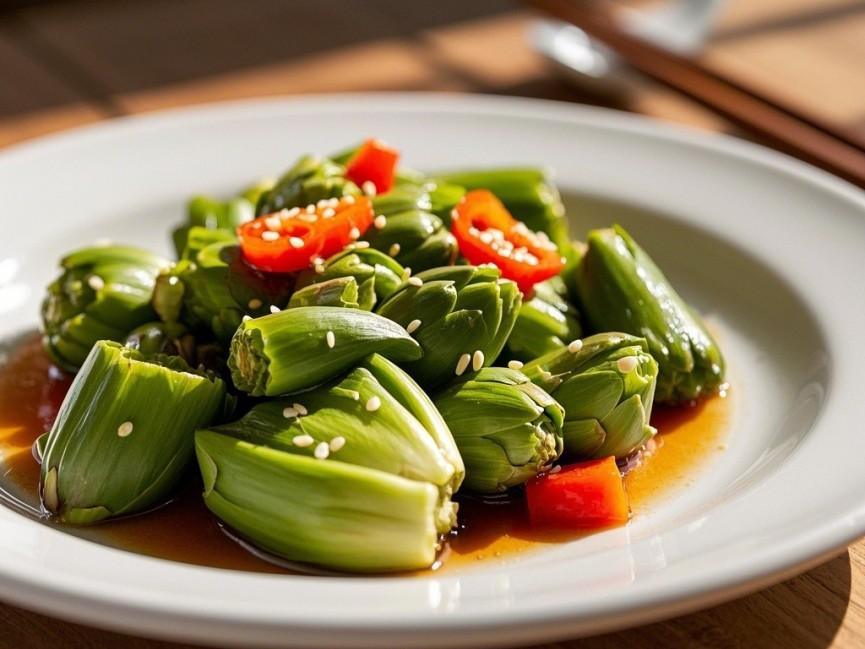
Currently, the total arable area of artichokes worldwide is about 80,000 hm2, 85% of which is concentrated in the Mediterranean Basin countries, with the main producing areas being Italy, Spain and France. Artichokes are now also cultivated in California, South America, Africa and some parts of Asia. In the 19th century, artichokes were introduced from France to Shanghai and other places for small-scale cultivation. Shandong, Shanghai, Jiangsu and other places have also carried out small-scale cultivation. Given its good development prospects, efforts should be made to promote its cultivation.
Reference
[1]Wang L,et al.Chlorogenic acid in tea samples by HPLC.J Instrum Anal,2001,20 : 1.
[2]Gabi-Siwa Zi.Magic Cynara Scolymus.Jiang FM translate.台 Taipei : Shimao Press,2001.34-37.
[3]Song SH,et al.Analysis of the nutritional composi- tion of Cynara Scolymus.J Nutrition,2006, (28) : 273-274.
[4]Katrin S,et al.Identification and Quantification of Caffeoyl quinic Acide and Flavonoids from Artichoke ( Cynara Scoly- mus L.) Heads,juice,and Pomace by HPLC-DAD-ES / MSn. Agric.Food chem,2004,52:4090-4096.
[5]Mulinacci N,Prucher D.Commercial and laboratory extracts from artichok leaves : estimation of caffeoyl esters and fla- vonoidic compounds content .Pharm Biom Anal,2004,34 : 349-357.
[6]Zhu XY,et al.Phenolic compounds from the leaf extract of artichoke( Cynara Scolymus L.) and their antimicrobial activ- ities.Agric Food Chem,2004,52:7272-7278.
[7]Liu R,et al.Phenolic Glucoside Gallates from the leaves of Cynara Scolymus.Acta Botanica Yunnancia,2005,31 : 89-92.
[8]Wang MF,et al.Analysis of Antioxidative phenolic com- pounds in artichoke ( Cynara Scolymus L.) .Agric Food Chem,2003,51 :601-608.
[9]Katrin S,et al.Characterization and quantification of antho- cyanins in selected artichoke ( Cynara Scolymus L.) culti- vars by HPLC-DAD-ESI-MSn.Anal.Biochem,2006,384 : 1511-1517.
[10]Hiroshi S,Ki yofumi N.Anti-hyperlipidemic sesquiterpenes and New sesquiter pene glycosides from the leaves of artichoke ( Cynara Scolymus L.) structure requirement and mode of action.Bioorg Med Chem Lett,2003,13 :223-228.
[11]Liu R,Hsieh Kun-Lung,Liu JK.A New Sesquiter- pene lactone from the leaves of Cynara Scolymus.Acta Botan- ica Yunnancia,2009,31 : 383-385.
[12]Li XL,et al.Sequiterpenoids from Cynara Scolymus.Hetero- cycles,2005,65 :287-291.
[13]Feranda E,Fabiane E.Antispasmodc activity of fractions and cynaropicrin from cymara scolymus on guinea-pigileum cy- nara scolymus.Biol Pharm Bull,2005,28 :902-904.
[14]Liu HW.Determination of asparagine in Cynara Scolymus by HPLC.Modern Scientific Instruments,2005,6 : 107-108.
[15]Katrin S,et al.Separation and quantification of inulin in se- lected artichoke( Cynara Scolymus L.) cuhivars and dandeli- on performance anion exchange chromatography with pulsed amperometric detection.Biomed.Chromatogr,2006,13 : 843- 846.
[16]Gebhardt R.Inhibition of cholesterol biosynthesis in Hep G2 cells by artichoke extracts if reinforced by glucosidase pre- treatment.Phytochem Anal,2002,16: 368-372.
[17]Adzet T,et al.Action of an artichoke extract against CC14- induced hepatotoxicity in rats.Acta Pharm Jugosl,1987,37 : 183-187.
[18]Brown JE,Rice-Evans CA.Luteolin-rich artichoke extract protects low density lipoprotein from oxidation in vitro.Free Radical Res,1990,29 (3) : 247-255.
[19]Rolf Gebhardt.Antioxidative and protective properties of ex- tracts from leaves of the artichoke ( Cynara Scolymus L.) against hydroperoxideinduced oxidative stress mcultured rathepatocytes.Toxicol Appl Pharmacol,1997,1144:279-286.
[20]Wang W,et al.Antioxidative phenolic compounds from sage (Salvia officinalis) .Agric Food Chem,1998,46:4869-4873.
[21]Wang M,et al.Antioxidative phenolic glycosides from sage (Salvia of licinalis) .Nat Prod,1999,62:454-456.
[22]Antonio JE,Lars OD.In vitro antichoke activities of edible artichoke,( Cynara Scolymus L.) and effect on biomarkers of antioxidants in rats.Agric Food Chem,2003,51 :5540-5545.
[23]Jimenez-Escrig A,et al.In vitro antioxidant activities of edi- ble artichoke ( Cynara Scolymus L.) and effect on biomarkers of antioxidants in rats.Agric Food Chem,2003,51 : 5540- 5545.
[24]Perez-Garcia F,et al.Activity of artichokeleaf extract on re- active oxygen species in human leukocytes.Free Radic Res, 2000,33 :661-665.
[25]Kraft K.Artichoke leaf extract-recent findings reflecting effects on lipid metabolism,liver,and gastrointestinal tracts. Phyto Medicine,1997,4: 369-378.
[26]Gebhardt R.Inhibition of cholesterol biosynthesis in primary cultured rat hepatocytes by artichoke( Cynara Scolymus L.) extracts.Pharmacol Exp Ther,1998,286 : 1122-1123.
[27]Englisch W,et al.Efficacy of artichoke dry extract in patients with bhyperlipoproteinemia.Arzneimittelforschung,2000,50 : 260-265.
[28]Li H,et al.Flavonoids from artichoke( Cynara Scolymus L.) up-regulate endothelial-typenitric-ox-ide synthase gene ex- pression in human endothelial cells.Pharmacol Ther,2004, 310:926-932.
[29]Rolf Gebhardt.Antioxidative and protective properties of ex- tracts from leaves of the artichoke ( Cynara Scolymus L.) against hydroperoxide induced oxidative stress mcultured rath- epatocytes.Toxicol Appl Pharmacol,1997,1144:279-286.
[30]Lupattelli G,et al.Artichoke juice improves endothelial func- tion in hyperlipemia.Life Sci,2004,76:775-782.
[31]Rodrguez S,et al.Choleretic activity and biliary elimination of lipids and bile acid induced by an artichoke leaf extract in rats.Phyto Medicine,2002,9 :687-693.
[32]Gebhardt R.Inhibition of cholesterol biosyntheis in primary cultured rat hepatocytes by artichoke( Cynara Scolymus L.) extracts.Pharmacol ExpTher,1998,286 : 1122-1128.
[33]Holtmann G,et al.Efficacy of artichoke leaf extract in the treatment of patients with functional dys-pepsia : a six-week placebo-conrolled ,double-blind ,multi-centre trial. Alim Pharmacol Therap,2003,18 : 1099-1105.
[34]Bundy R,et al.Artichoke 1eaf extract reduces symptoms of irritable bowel syndrome and improves quality of Iife in otherwise healty volunteers suffering from concomitant dyspep- sia : a subset analysis.Altern Complem Med,2004,10 : 667- 669.
[35]Gebhardt R.Anticholestatic activity of flavonoids from arti- choke( Cynara Scolymus L.) and of their metabolites.Med Sci Monit,2001,7(Suppl 1) : 316-320.
[36]Saenz Rodriguez T,Garcia Gimenez D.de 1a Puerta Vazquez,R.Choleretic activity and biliary elimination of 1ipids and bile acids induced by artichoke leaf extract in rats.Phyto Medicine,2002,9 :687-693.
[37]Gebhardt R.Prevention of aturolithocholate-induced hepat- icbile canalicular distortions by HPLC-characterized extracts ofartichoke ( Cynara Scolymus L.) leaves.Planta Med, 2002,68 :776-779.
[38]Lupattelli G,et al.Artichokejuice improves endothelial function in hyperlipemia.Life Sci,2004,76:775-782.
[39]Ferran SR,et al.Indentification of phenolic compounds in ar- tichoke waste by high performance liquid chromatography- tandem mass spectrometry.Chromatogr Anal,2003,1008 :57- 72.
[40]Bai X,et al.Cynara Scolymus nutrition and health function.China Food Andnutrition, 2005,11 :48.


 English
English French
French Spanish
Spanish Russian
Russian Korean
Korean Japanese
Japanese